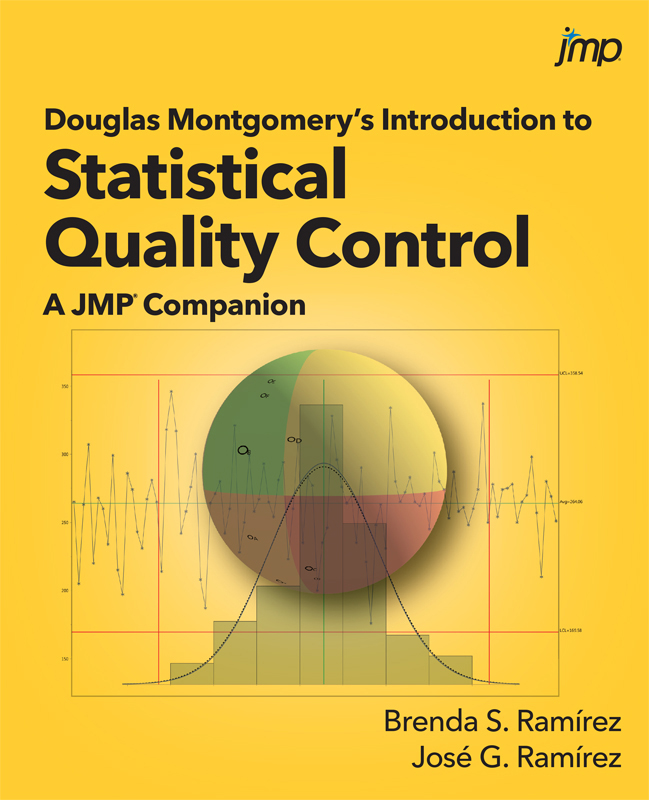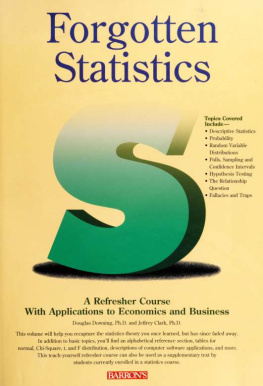Montgomery Douglas C. - Douglas Montgomery’s Introduction to statistical quality control: a JMP companion
Here you can read online Montgomery Douglas C. - Douglas Montgomery’s Introduction to statistical quality control: a JMP companion full text of the book (entire story) in english for free. Download pdf and epub, get meaning, cover and reviews about this ebook. year: 2018, publisher: SAS Institute Inc., genre: Children. Description of the work, (preface) as well as reviews are available. Best literature library LitArk.com created for fans of good reading and offers a wide selection of genres:
Romance novel
Science fiction
Adventure
Detective
Science
History
Home and family
Prose
Art
Politics
Computer
Non-fiction
Religion
Business
Children
Humor
Choose a favorite category and find really read worthwhile books. Enjoy immersion in the world of imagination, feel the emotions of the characters or learn something new for yourself, make an fascinating discovery.
- Book:Douglas Montgomery’s Introduction to statistical quality control: a JMP companion
- Author:
- Publisher:SAS Institute Inc.
- Genre:
- Year:2018
- Rating:5 / 5
- Favourites:Add to favourites
- Your mark:
- 100
- 1
- 2
- 3
- 4
- 5
Douglas Montgomery’s Introduction to statistical quality control: a JMP companion: summary, description and annotation
We offer to read an annotation, description, summary or preface (depends on what the author of the book "Douglas Montgomery’s Introduction to statistical quality control: a JMP companion" wrote himself). If you haven't found the necessary information about the book — write in the comments, we will try to find it.
Douglas Montgomery’s Introduction to statistical quality control: a JMP companion — read online for free the complete book (whole text) full work
Below is the text of the book, divided by pages. System saving the place of the last page read, allows you to conveniently read the book "Douglas Montgomery’s Introduction to statistical quality control: a JMP companion" online for free, without having to search again every time where you left off. Put a bookmark, and you can go to the page where you finished reading at any time.
Font size:
Interval:
Bookmark:

The correct bibliographic citation for this manual is as follows: Ramirez, Brenda S., M.S., and Jose G., Ramirez, Ph.D. 2018. Douglas Montgomerys Introduction to Statistical Quality Control: A JMPCompanion. Cary, NC: SAS Institute Inc.
Douglas Montgomerys Introduction to Statistical Quality Control: A JMPCompanion
Copyright 2018, SAS Institute Inc., Cary, NC, USA
978-1-63526-022-9 (Hard copy)
978-1-63526-825-6 (Web PDF)
978-1-63526-823-2 (epub)
978-1-63526-824-9 (mobi)
All Rights Reserved. Produced in the United States of America.
For a hard copy book: No part of this publication may be reproduced, stored in a retrieval system, or transmitted, in any form or by any means, electronic, mechanical, photocopying, or otherwise, without the prior written permission of the publisher, SAS Institute Inc.
For a web download or e-book: Your use of this publication shall be governed by the terms established by the vendor at the time you acquire this publication.
The scanning, uploading, and distribution of this book via the Internet or any other means without the permission of the publisher is illegal and punishable by law. Please purchase only authorized electronic editions and do not participate in or encourage electronic piracy of copyrighted materials. Your support of others rights is appreciated.
U.S. Government License Rights; Restricted Rights: The Software and its documentation is commercial computer software developed at private expense and is provided with RESTRICTED RIGHTS to the United States Government. Use, duplication, or disclosure of the Software by the United States Government is subject to the license terms of this Agreement pursuant to, as applicable, FAR 12.212, DFAR 227.7202-1(a), DFAR 227.7202-3(a), and DFAR 227.7202-4, and, to the extent required under U.S. federal law, the minimum restricted rights as set out in FAR 52.227-19 (DEC 2007). If FAR 52.227-19 is applicable, this provision serves as notice under clause (c) thereof and no other notice is required to be affixed to the Software or documentation. The Governments rights in Software and documentation shall be only those set forth in this Agreement.
SAS Institute Inc., SAS Campus Drive, Cary, NC 27513-2414
October 2018
SAS and all other SAS Institute Inc. product or service names are registered trademarks or trademarks of SAS Institute Inc. in the USA and other countries. indicates USA registration.
Other brand and product names are trademarks of their respective companies.
SAS software may be provided with certain third-party software, including but not limited to open-source software, which is licensed under its applicable third-party software license agreement. For license information about third-party software distributed with SAS software, refer to http://support.sas.com/thirdpartylicenses .
Contents
Foreword
Statistical Process Control or SPC has been called one of the greatest technological innovations of the 20th century. I think this is because the techniques have a sound intuitive basis, are straightforward mathematically, and have broad applicability to a wide range of industrial and business environments, including but not limited to manufacturing, process development, product design, supply chain operations, financial operations, health care, logistics and distribution, and many other transactional and service operations. The application of SPC along with other techniques for quality and business improvement have led to significantly improved quality and reliability of many products and services and contributed in an important way to business success and economic development.
Two other innovations have also played a key role in the successful deployment of SPC and other quality improvement tools. These are the use of deployment frameworks, the most successful of which in my view is Six Sigma, and computer software. Because SPC can be very data-intensive appropriate software is essential to any successful application, and JMP is an outstanding package. It has all of the fundamental and advanced techniques that are necessary to a successful SPC implementation.
The authors have done an excellent job of demonstrating how the key ideas of SPC in my book, both basic Shewhart control charts, and more advanced techniques, can be implemented in JMP. The software package has a logical design and the authors provide detailed step-by-step help along with screen shots and output from JMP to guide the reader to successful use of the technology. In many places they also provide additional insights about the methodology or extensions of some of the basic ideas that are extremely useful to the practitioner. The authors have an extensive background in the application of these methods across a variety of industrial and business settings, and this comes through clearly in the writing. Some of their own innovations such as measures of process stability are included and thoroughly illustrated in the book.
I highly recommend this book. It is well-written, and provides clear, authoritative guidance on the implementation of SPC through the JMP software package. Even if you are an experienced JMP user you will find the book a rewarding and useful reference. For new users, the book is an invaluable aid that will quickly facilitate your successful use of the SPC toolkit.
Douglas C. Montgomery
Regents Professor of Industrial Engineering
ASU Foundation Professor of Engineering
Ira A. Fulton School of Engineering
Arizona State University, Tempe, AZ
About This Book
What comes to mind when you think of statistical quality control (SQC)? The Encyclopedia Britannica defines this phrase as the use of statistical methods in the monitoring and maintaining of the quality of products and services. This definition is in line with our initial exposure to SQC during our college years, in classes like Statistical Process Control. These ideas continued to take shape when we studied for the American Society for Quality Certified Quality Engineering exam, which had us memorize numerous facts about different statistical quality tools. But it was not until we started using these tools and techniques in a real-world manufacturing environment that we truly understood their impact on improving products and processes.
Thirty years and several industries later, we have become great stewards of SQC techniques, and their use and application have become second nature. Therefore, when we were asked to author a companion book to Prof. Montgomerys Introduction to Statistical Quality Control (ISQC), we enthusiastically agreed. Like many, we were introduced to his work through his many books. They are among our favorites because they are very readable, practical, and relevant, not only to the industries that we have worked in but also to the engineers and scientists with whom we often interact. This is no coincidence since Professor Montgomery holds BS, MS, and PhD degrees, all in engineering, and has spent many years both as a professor of Industrial Engineering and Statistics at Arizona State University and as a practitioner collaborating with people in industry.
The synergy between engineering, science, and statistics is always found in Prof. Montgomerys teachings. Take ISQC, for example. This book provides applications for many of the common SPC techniques using data sources from well-known manufacturing and business processes. For example, the book educates the reader about XBar and Range charts using dimensional measurements from a Hard-Bake process, C charts are applied to nonconformities on a printed circuit board, and we interpret the results of an attribute gauge capability analysis to understand the consistency of a manual underwriting process for mortgage loan applications. ISQC Chapter 10, Other Univariate Statistical Process-Monitoring and Control Techniques, contains many useful monitoring techniques that are very effective in practice but may be overlooked or misunderstood. We encourage you to check out his discussions for how to adapt SPC charts for the following scenarios: short production runs, nonstationary and autocorrelated output, change-point models, profile monitoring, and multistream processes.
Font size:
Interval:
Bookmark:
Similar books «Douglas Montgomery’s Introduction to statistical quality control: a JMP companion»
Look at similar books to Douglas Montgomery’s Introduction to statistical quality control: a JMP companion. We have selected literature similar in name and meaning in the hope of providing readers with more options to find new, interesting, not yet read works.
Discussion, reviews of the book Douglas Montgomery’s Introduction to statistical quality control: a JMP companion and just readers' own opinions. Leave your comments, write what you think about the work, its meaning or the main characters. Specify what exactly you liked and what you didn't like, and why you think so.












